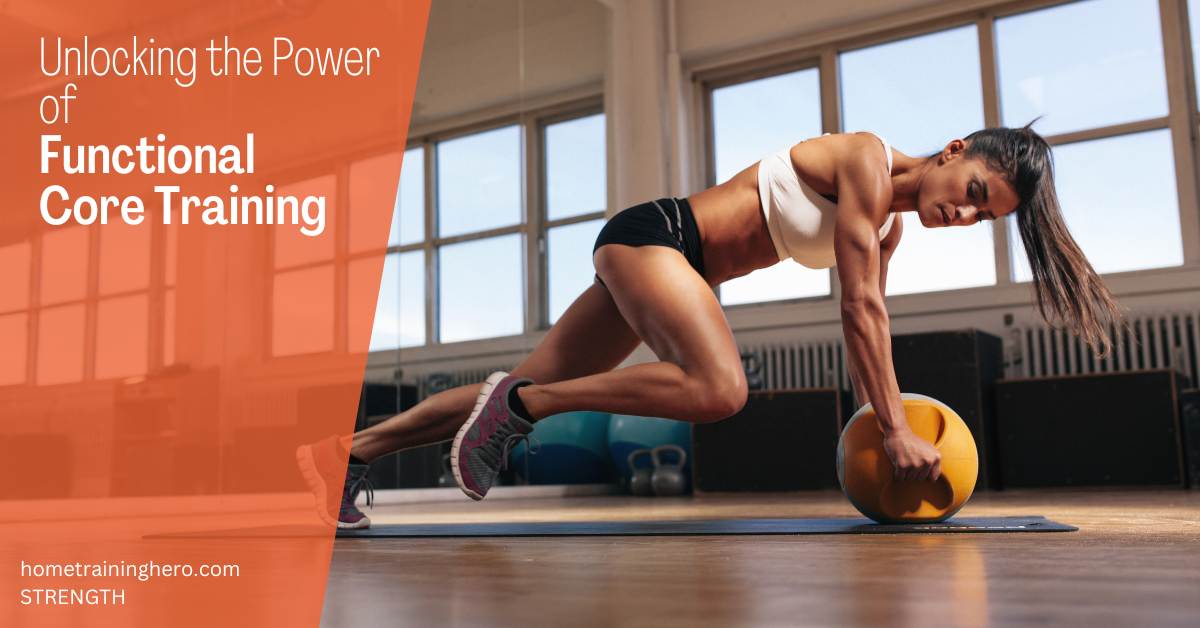Functional core training has gained immense popularity in recent years due to its ability to improve overall fitness and enhance athletic performance.
This article aims to unlock the power of functional core training and provide you with a comprehensive understanding of its benefits, exercises, and how it can help you achieve your fitness goals.
Let’s get to it!
Contents
The Importance of a Strong Core
Before diving into the specifics of functional core training, it is crucial to understand the importance of having a strong core.
Your core muscles are not just limited to the abdominal area; they include all the muscles surrounding your pelvis, lower back, hips, and abdomen. These muscles play a vital role in stabilizing your spine, maintaining proper posture, and transferring force throughout your body.
A weak core can lead to various issues such as poor balance, lower back pain, decreased athletic performance, and increased risk of injuries.
On the other hand, a strong and functional core provides a solid foundation for all movements, improves stability, and enhances movement efficiency.
What is Functional Core Training?
Functional core training focuses on strengthening the core muscles in a way that mimics real-life movements and challenges them in multiple planes of motion.
Unlike traditional core exercises that isolate specific muscles, functional core training emphasizes using the core muscles in conjunction with other muscle groups to promote overall functional strength and stability.
The Benefits of Functional Core Training
Functional core training offers numerous benefits that can positively impact your daily life, sports performance, and overall fitness. Here are some key advantages:
- Better Posture: Functional core exercises target the muscles responsible for maintaining proper posture, helping you develop a tall and balanced stance.
- Injury Prevention: A strong core enhances stability and reduces the risk of injuries by improving muscle coordination and balance.
- Improved Athletic Performance: Functional core training enhances your ability to generate and transfer power, leading to improved sports performance in activities such as running, jumping, and throwing.
- Enhanced Everyday Movements: Strong core muscles not only make daily movements easier but also improve your ability to perform functional tasks like lifting heavy objects, bending, and twisting.
- Increased Core Strength: Functional core exercises target multiple muscle groups simultaneously, resulting in greater overall core strength compared to isolated exercises.
Effective Functional Core Exercises
Now that you understand the importance and benefits of functional core training let’s explore some effective exercises that can help you build a stronger core:
Plank Variations
The plank is a classic exercise that targets the entire core region.
Start in a push-up position, with your elbows directly beneath your shoulders and your body forming a straight line. Hold this position for as long as possible while maintaining proper form. To add variation, try side planks or plank leg lifts.
Medicine Ball Russian Twists
Sit on the floor with your knees bent and feet flat on the ground. Hold a medicine ball or weight with both hands close to your chest.
Lean back slightly and twist your torso to one side, bringing the ball or weight towards the ground. Return to the starting position and repeat on the other side. This exercise targets your obliques and improves rotational strength.
Stability Ball Rollouts
Begin on your knees with your hands placed on a stability ball in front of you.
Slowly roll the ball forward, extending your arms while maintaining a neutral spine.
Once you feel a stretch in your core, reverse the movement and return to the starting position. This exercise engages your deep abdominal muscles and challenges core stability.
Designing Your Functional Core Training Program
To optimize the effectiveness of your functional core training, it is important to design a well-rounded program that targets all aspects of core strength and stability.
Here are some key points to consider:
Exercise Selection
Choose a variety of exercises that target different core muscle groups and challenge them in various planes of motion.
Incorporate exercises that involve flexion, extension, rotation, and lateral movements to ensure comprehensive development.
Progression and Variation
As you become stronger and more proficient, progressively increase the difficulty of your exercises.
This can be done by adding resistance, increasing repetitions, or trying advanced variations of familiar exercises. Continually challenging your core muscles will lead to ongoing improvements.
Proper Form and Technique
Pay close attention to your form and technique during each exercise to ensure maximum effectiveness and minimize the risk of injury.
Engage the core muscles throughout the entire movement and avoid compensating with other muscle groups.
Recovery and Rest
Allow for adequate recovery between training sessions to give your muscles time to repair and grow stronger.
Overtraining can hinder progress and increase the risk of injury. Aim for 1-2 days of rest between intense core workouts.
Incorporating Functional Core Training into Your Routine
Functional core training can be incorporated into your existing workout routine or performed as a standalone session.
Aim to include at least two dedicated core training sessions per week, with exercises targeting all major core muscle groups. It can be helpful to work with a qualified fitness professional to design a personalized program that aligns with your specific goals and needs.
Final Words
Unlock the power of functional core training and take your fitness journey to new heights!
By incorporating these effective exercises and principles into your routine, you’ll develop a strong and functional core that enhances your overall performance, reduces the risk of injuries, and improves your quality of life.
Remember to stay consistent, challenge yourself, and enjoy the process of building a stronger core!


